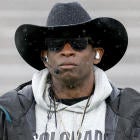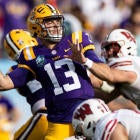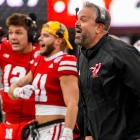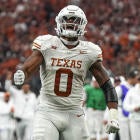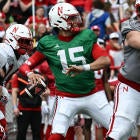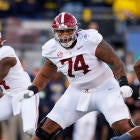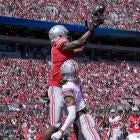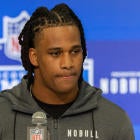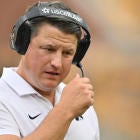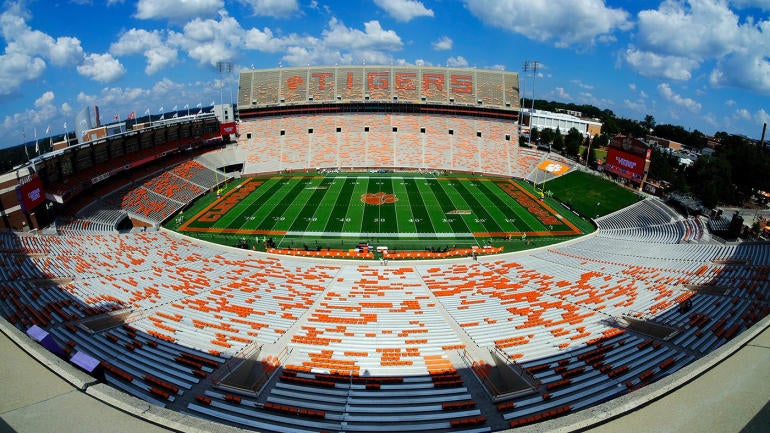
Eight weeks before the 2020 college football season kicks off, there is no uniform NCAA testing procedure in place for forthcoming fall practices and game weeks. And it will be difficult for the NCAA to mandate an overarching national policy because of liability concerns.
The Power Five commissioners are attempting to come up with a testing protocol they can then bring to the Group of Five for an agreement, but the diverse composition and budgets of the 130 FBS schools make such an endeavor doubly complicated. There are 41 states that have at least one FBS college football program, and the local and state health boards of those states will want their say as well.
Even to this point, testing across college football has been inconsistent (if it is done at all).
For those who say America needs football to play through the virus, that hasn't worked well so far. What college football fans need is for the country to corral the virus enough so that the sport can be played.
"We're trying to play football on the upswing of a global pandemic," said Randy Cohen, Arizona's associate athletics director for medical services. "Can we accomplish it? The odds are probably not very good."
Alarmist?
An athletic director who spoke under the condition of anonymity told CBS Sports there is a Power Five school with one ICU bed in town.
"This epidemic isn't going away," said Dr. Michael Saag, UAB's professor of medicine and infectious diseases. "It's quite likely a year from now you and I could be having the same conversation. What will be different is there will be more people infected. … How do we cope with that as a country?"
Saag was unique among the experts CBS Sports spoke with regarding how college football can medically, ethically and legally returns to play on time.
From his Birmingham, Alabama, office, he doesn't have to look far to see the problems. America's approach to the coronavirus -- and the laissez faire approach to mask wearing, which has been proven by simple science to significantly reduce risk of infection -- translates easily to the field.
"It's almost like watching Alabama-Auburn play," Saag said. "Everybody is so entrenched in their own political space. ... That is at the heart at why we are failing [to flatten the coronavirus curve] as a country."
That is less a political statement than a front-row seat to history. You see, Saag spent 14 treacherous days himself battling COVID-19 earlier this year. He has spent more than 30 years researching HIV. The man knows viruses.
Living in the South, he also knows college football. Saag, 64, wants it to come back as much as anyone, but the signs, as of right now, are not good.
As far as he is concerned, college football can be played safely only if the United States steps up. The country, he says, is at war. Some might argue college football players are being used as human shields in the battle.
"We're at war against an invisible enemy that has invaded our country. To fight a war effectively, we need central command and control. That is absent," he said.
The same could be said of college athletics in this coronavirus battle. Schools are testing at different rates with different frequencies with no central command to ensure everyone is on the same page. It's certainly not the NCAA, whose guidelines during this pandemic are just that -- unenforceable, best-practice suggestions.
Large-scale testing can be done. Saag is in the process of helping test all 265,000 students in the Alabama university system in a 3.5-week period later this summer.
"If you asked me a month ago, I would have said 1-2% [infection rate] of returning students," Saag said. "Looking at the current surge, that number could now be 3-5-7%. If that's the case, all the campuses are at risk. So are the college athletes."
Extrapolated over 13,000 FBS players, that's 400-1,000 infected athletes, the equivalent of 4-10 entire teams.
As of Sunday, positive infection rate was up in more than half the 50 states. Some governors are slowing reopenings. Several football programs have paused voluntary workouts during the rash of positives.
Time is quickly slipping away as an advantage for college football. Monday marks exactly two months until the season kicks off.
In order for that to happen, comprehensive COVID-19 testing procedures must be in place. The FBS is still modeling uniform testing procedures and frequency during game weeks.
Concerns with considering 'herd immunity'
Herd immunity has become sort of an unspoken "cure" for college football. The term refers to the concept of large portions of a population building up immunity by catching and recovering from the virus.
"You hear the Clemson story, up to 37 players have tested positive," Saag said. "Some people have said, 'Oh, they're doing that on purpose so that they'll have everybody immune by the time the season starts.' I can't believe they're deliberately infecting people."
No, they're not. In truth, herd immunity has holes. According to the Mayo Clinic, it took a 94% infection rate for herd immunity to develop for the measles.
Saag said the herd immunity infection rate for the coronavirus is approximately 70%.
"If the players lived only in the bubble of that locker room, it could work," he said. "But we know they're going to be in class."
And at parties and at bars. In the case of the outbreaks at LSU and Kansas State recently, players were known to be out socially.
How do you keep college students from being college students?
The Toledo Blade recently asked an epidemiologist what would be wrong with a batch of asymptomatic cases running through a team?
"You're still creating new cases in a global pandemic, so -- and you can print this -- f--- you. That really makes me quite angry," Emory University's Zachary Binney told the paper.
The Big 12 has contracted with North Carolina-based Infectious Control Education for Major Sports (ICS) for its testing and mitigation strategy. ICS also has the NFL, MLB and NHL as clients.
The firm was formed by two infectious disease doctors who specialize in epidemiology. Herd immunity is not part of their work with the Big 12.
"Herd immunity is not a realistic expectation in the near term as it would require some degree of prior infection among virtually everyone a player would come in contact with," said ICS partner Dr. Christopher Hostler. "Even if every player gets infected, we can't say for sure that they would be immune from subsequent reinfection."
Coaches are at great risk, too
College-age players may have an extremely low rate of hospitalization and death, but coaches -- especially those over 60 -- are more susceptible.
TCU coach Gary Patterson revealed that special assistant Jerry Kill recently overcame a bout with the coronavirus.
Kill, 58, is one of the toughest individuals, well, anywhere. He has a form of epilepsy that has previously caused him to collapse on the sidelines. He has beaten cancer multiple times. Health concerns forced him to resign in the middle of the 2015 season as he was leading Minnesota. Now this.
"He went out to dinner," Patterson said. "Everybody thinks it's about the kids coming back. It's about how you live your life doing everything else."
There at 17 FBS head coaches age 60+ going into the season with Frank Solich of Ohio is the oldest at 75. That's not to mention numerous assistant coaches and program staffers that are at higher risk due to their ages, preexisting medical conditions or a combination of both.
Testing, testing, testing
There are three main types of testing, none of them foolproof. They generally range in price from $40-$120 per test. The tests can be collected by nasal swabs or saliva. The intrusive "cranial dip" test that reaches deep into the nasal cavity is considered the gold standard.
- Viral PCR test: The best, most accurate test. It only misses an estimated 10% of infections and can take up to a week to turnaround results depending on the lab and efficiency of overnight mail.
- Antigen test: The fastest, least-expensive test that can be turned around in a day or as little as 30 minutes. Sounds good, right? Unfortunately, the quick turnaround necessitates having the appropriate equipment, and this test misses 20-30% of infections.
- Antibody test: A blood test that only works after the infection is over. Usually 14-21 days after infection, antibodies show up in the bloodstream. There is an increased risk for false positives and false negatives. Turnaround time depends on equipment, and a positive test does not necessarily mean you are immune. "[The antibody test is] not good for college football. You could be infected today. … You could be playing for three weeks and infecting people," Saag said.
Aside from consistent, comprehensive testing procedures, it's the philosophy of testing that needs to be determined. Some schools, like Arizona, are spending $1 million this summer to test every athlete who comes to campus.
But what about fall practice and game weeks? If it takes multiple days to learn about infections unless schools are financially able to purchase the expensive but necessary equipment to receive more rapid results, questions arise.
How often will players actually be tested? Will they be tested within 24 or 48 hours of kickoff? Will they be placed in a bubble -- such as a team hotel or dormitory -- between taking the final test and stepping on the field?
The Blade reported three MAC schools were testing only when symptoms were present. That raises a question for those MAC opponents going forward: Do you want to play a MAC school that could potentially have a raging asymptomatic spread?
"The issue is not going to be, 'Do you have positives?'" said TCU AD Jeremiah Donati. "It's going to be, 'How many, and are you going to be able to manage and control an outbreak?'"
Still undetermined nationally is what would constitute the cancellation or postponement of a game due to lack of player availability.
And God forbid any athlete becomes sick. Saag came close to being hospitalized with COVID-19 in March.
"It's horrible," he said. "Fever, chills, body aches, inability to sleep, loss of appetite, shortness of breath, monitoring oxygen levels."
Oklahoma is among the last handful of FBS programs to open camps this week. Voluntary workouts will begin July 1, a month after the NCAA lifted a moratorium against athletic activities.
"People say Lincoln Riley was looking smarter and smarter [for starting later]," one Power Five coach said. "I don't think so. No matter what you think your plan is, you better slowly but surely get them in here work through all the kinks and kids understand the routine.
"I'd rather [positives] happen to me the middle of June. How many athletes have you heard have been critical condition because of the virus?"
None in college football. Yet.













